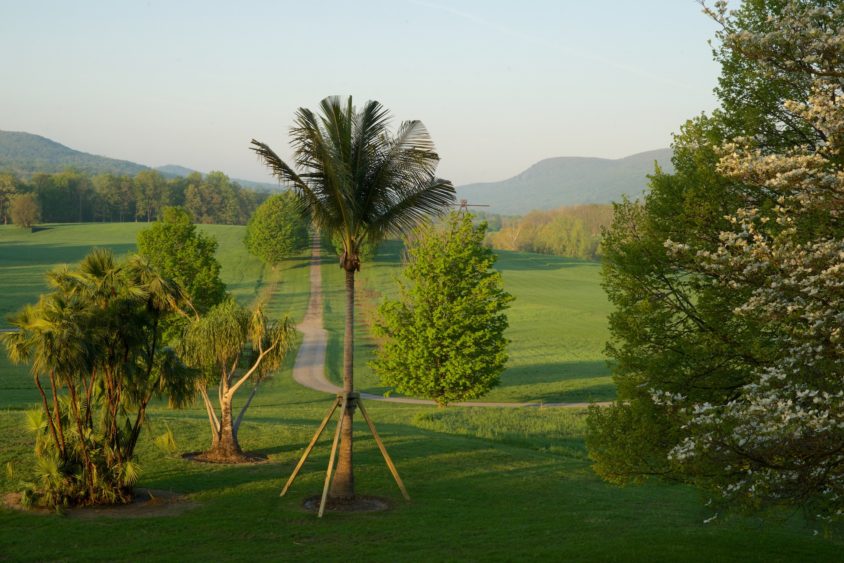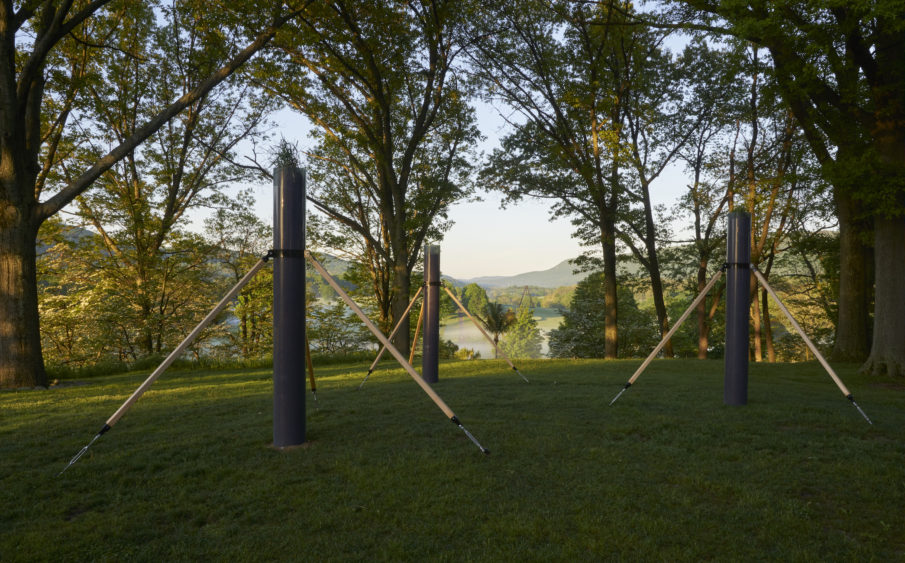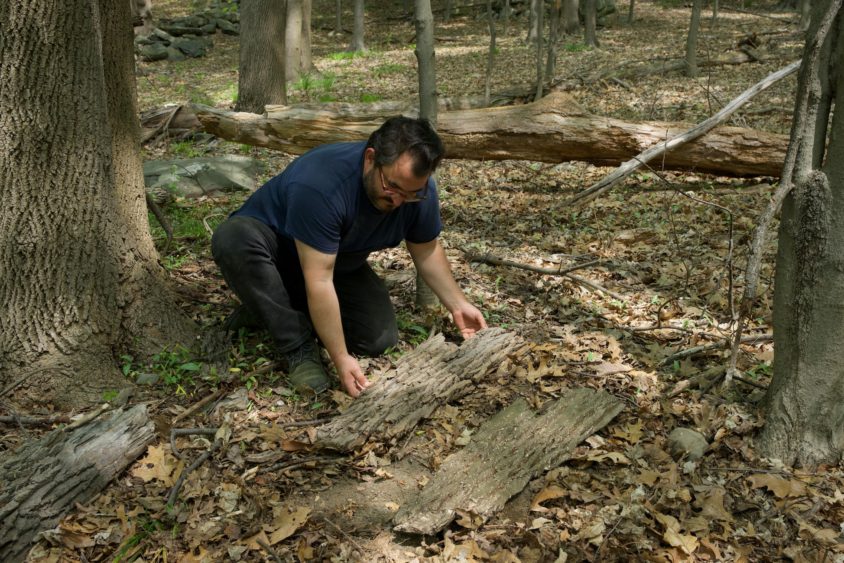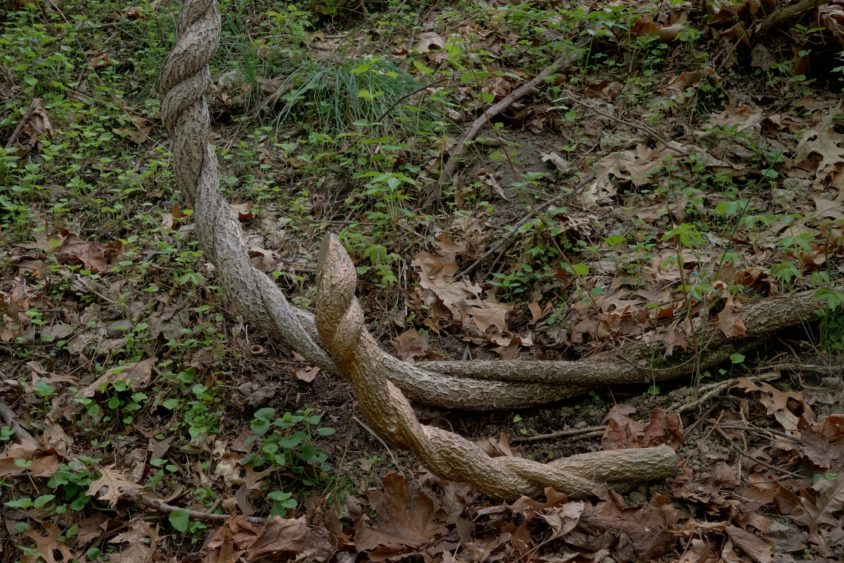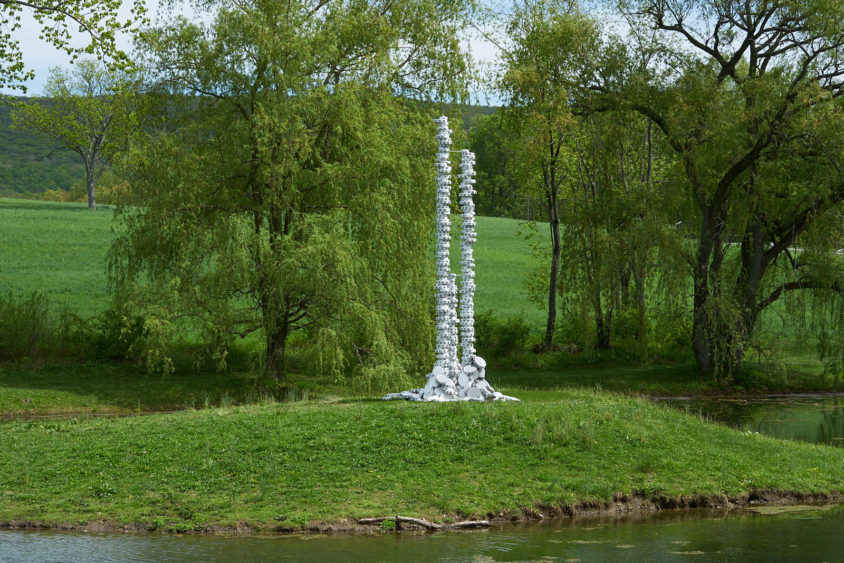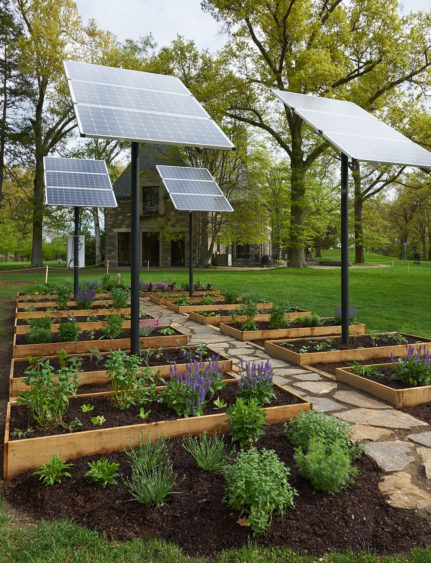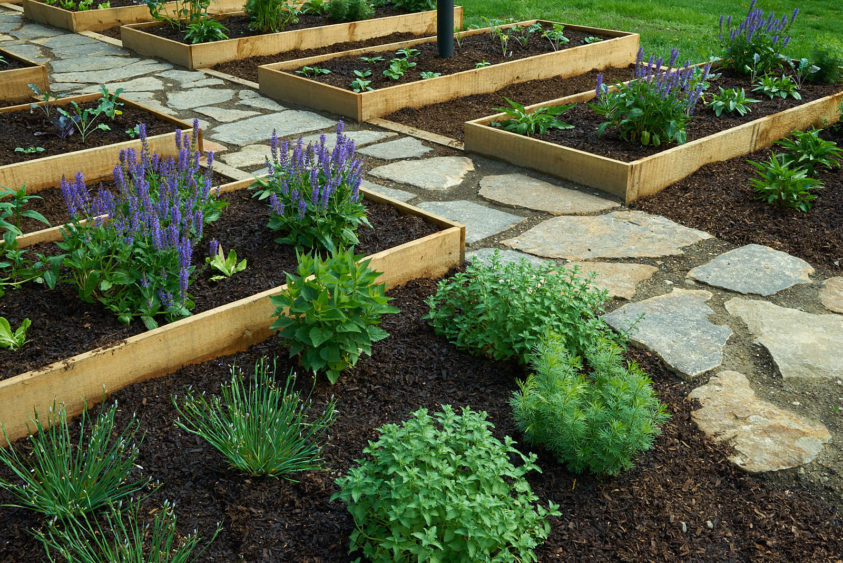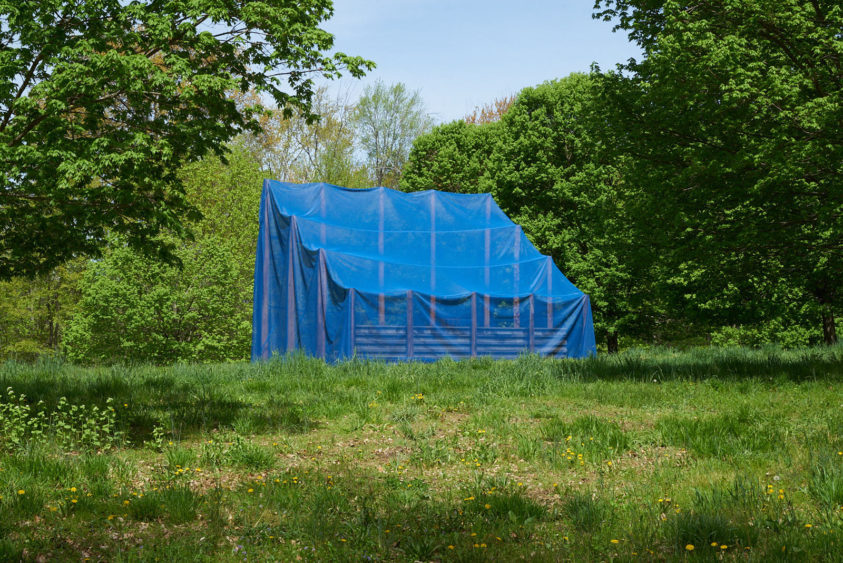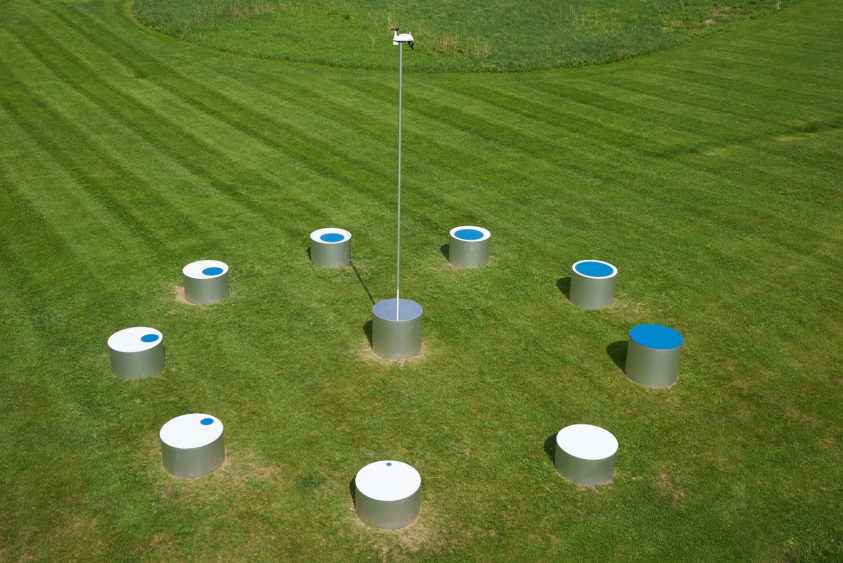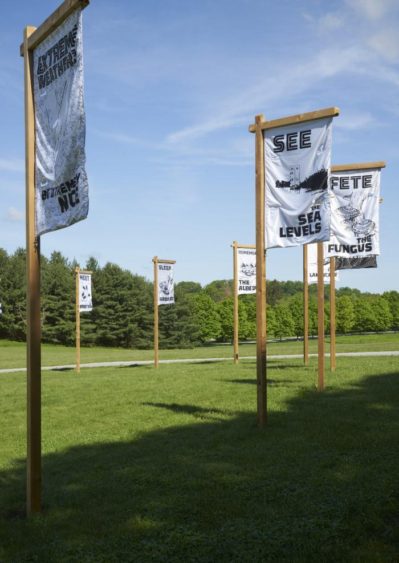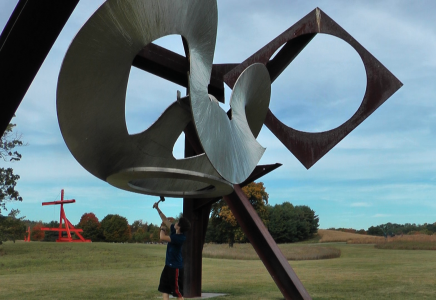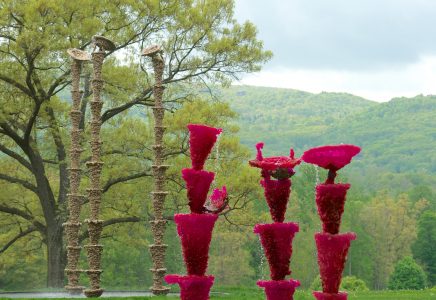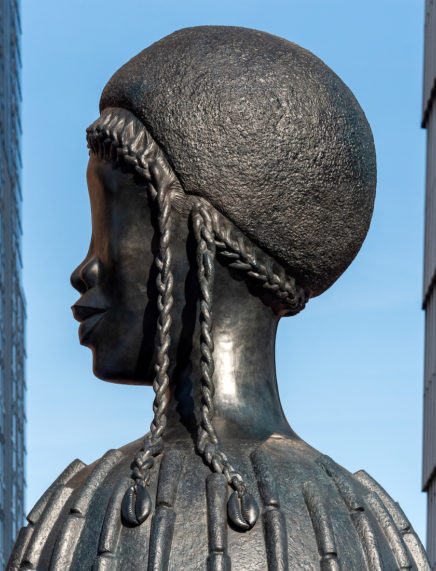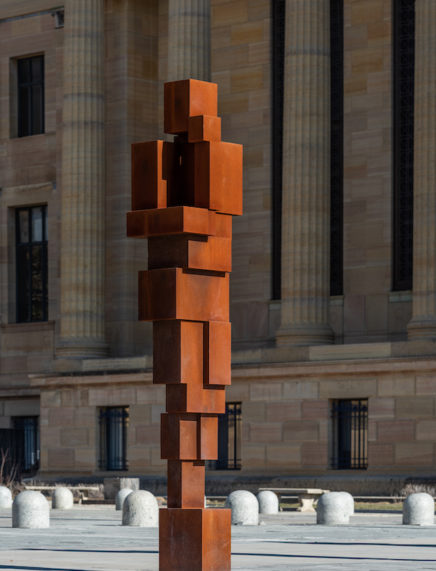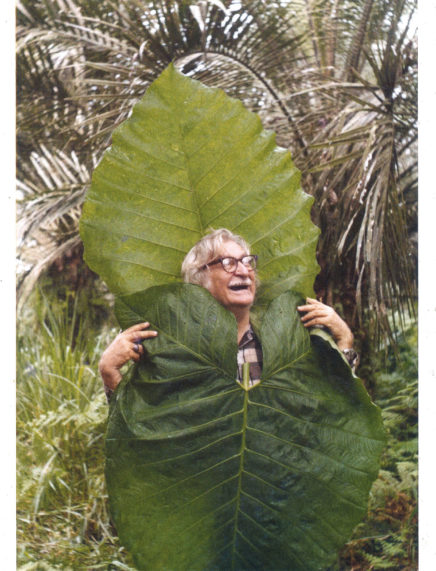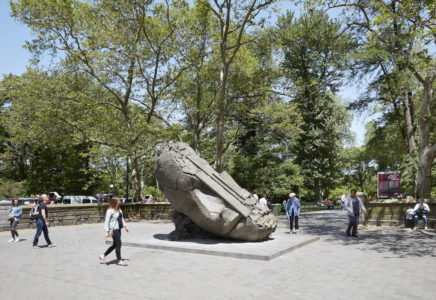Indicators: Artists on Climate Change
at Storm King Art Center
Storm King Art Center, the 500-acre sculpture garden a bit more than an hour north of New York City, is offering a group show titled Indicators: Artists on Climate Change. The exhibition displays the efforts of seventeen artists (see list below), who are presenting outdoor works and pieces housed indoors in the main building welcoming visitors to the site. No matter what the ecological reactionaries say, it is clear we are in the midst of a permanent climate change–one that has already profoundly altered the way we live. The seventeen artists are committed mostly to informing their audience about these circumstances, although a few works actually attempt to effect change in favor of sustainability and a less heated climate. However pessimistic our situation may be–and we are right to come close to hopelessness–it is important not to give up educating the world about the consequences of rising temperatures. Given the Malthusian proportions of our world’s population and the need to feed them, hugely increased amounts of generaged power are needed to grow crops, build homes (and heat them), and generally take care of people. This of course requires exponential amounts of energy, whose production has come close to poisoning the already damaged atmosphere between heaven and earth.
In the face of imminent catastrophe, what can an artist do to make the gravity of the situation public? The artists are showing their works in a major public art space, and all the pieces address the problem of climate change–even if the works do not do so in an easily accessible manner. Merging art with a well-defined social theme has often been successful–in large part because artists tend to like their independence considerably, and often (not always) chafe under any yoke of authority, public or not. This review will cover the work of several but not all of the artists in the show. Interestingly, because those seen in this exhibition are making work directed toward a specific theme, sometimes it is hard to see the art as transcending its public role. But equally often the transmission of ecological concern is both high and intense, communicating general concern for the decay of our environment. The artists mentioned in this text have been chosen nearly randomly–everyone has made strong work, even if that work’s visuals have taken second place to the ecological politics being adumbrated.
Maya Lin, the prominent Chinese-American public artist best known for her Vietnam memorial in Washington, D.C., offers three transparent ten-foot poles, each them containing a single stalk of prairie grass, with the tips of the grass making their way out of the top of the tubes, each of which are supported by struts. According to Lin, the use of this kind of grass references Storm King’s decision to rework native grasses and vegetation into its land, and the artist also comments that prairie grass could be used to actively absorb carbon from the atmosphere, thus ameliorating the near-to-permanent damage effected by climate change. Lin, who is superb when she is working between the interstices of land sculpture and public presentations, here has fashioned a somewhat schematic presentation for change. The visual interest of the tubes does not fully stand up to the lyricism of the artist’s thinking. This is hardly Lin’s fault, but the problem of limited visual achievement, in favor of conceptual vision both poetic and practical in intent, does tend to limit the experience–if not the idea–of some of the work. Despite this problem, the show holds out the promise of a visionary stance relegating history, nature, and culture to an outlook that would in fact have a positive influence on what is a nearly intractable problem. Two low reliefs, made by Lin in 2017, exquisitely capture the Arctic and Antarctic landmasses in white. Made of paperboard and encaustic, they form a lyric understanding promoted by the artist’s real sensitivity to the natural world.
Meg Webster, another visionary artist intent on bringing about real change, is offering the solar-panel-driven installation named Growing Under Solar Panels (2018). Working with two scientists–Stephen Herbert, a professor of agriculture teaching in Amherst, Massachusetts, and David Marley, who runs a company devoted to installing large-scale solar systems–Webster found that the spacious placement of the solar panels used in this project enabled the greater growth of local plants and wildflowers placed in wooden trays. The panels supply energy to a watering system that brings water in from pools close by. According to press notes, the panels and their supports have a strong sculptural presence in their own right, but this is not so certain. The forms are industrial and therefore inherently practical. They come close to reading as a current intrusion on the landscape, which is older beyond words. But the formal aspects of Webster’s project don’t have to be closely scrutinized. The idea of the piece is magical, along the strong sense of collaboration–among people and between nature and new technology.
Sculptor David Brooks contributed several works in his piece, called Permanent Field Observations (2018). Roots, rocks, and branches were duplicated in bronze, with the latter forms being attached close by–and permanently–to the organic natural forms they copy. Over time, of course, the organic ephemera will slowly rot away into the ground, while the manmade, culturally suggestive bronzes will survive. There is irony but probably little humor to the contrast. Because they are going to last for more than a while, the bronze casts will stand as living memories more or less invulnerable to time, while the original object will not. It is melancholic to recognize nature’s vulnerability, but the notion of change over a relatively quick duration is key to our understanding of certain natural processes. Culture changes too, but these bronze works are copies that have a likely limitless lifespan, even though they do not live on reality–as the roots and branches they mimic do. As a result, our view of these almost exactly similar pairs of objects is tinged with the awareness that culture is a closed system–the bronze casts last longer but never do more than mimic nature. They exist outside normal, natural time–but they also are, as Brooks points out in his title, “permanent.” Looking at a pair of twisting roots side by side, or a copied clump of wood resting next to the original, Brooks’ audience has no choice but to acknowledge the endlessness of the bronze version, in comparison with the slowly molding wood that is naturally real.
Mary Mattingly’s transfer of a palm tree, coconut palms, and a ponytail palm from the tropics to the mid-Hudson area in New York comprises the visual center of her outdoor installation, entitled Along the Lines of Displacement: A Tropical Food Forest (2018). These plants may well become a natural part of the landscape in upstate New York; scientists believe that the temperature may rise more than seven degrees Fahrenheit by the end of this century. It is more than a little disturbing to think of palm trees thriving in an area where they currently don’t exist. But this is the future we are facing. Mattingly’s small clump of trees in the middle of an open field doesn’t claim us culturally, but rather in light of a permanently changed nature. Most people agree trees are a good thing, but the sheer eccentricity of a palm tree up north reminds us that we find aberrations in the flora of our immediate surroundings highly disturbing. We might say, “It isn’t natural to have these trees here.” And that is exactly Mattingly’s point.
For the LED panel work entitled We Are the Asteroid (2018), Justin Brice Guariglia wrote several short sentences or phrases, with the help of academic eco-critic Timothy Morgan: “Danger: Anthropocentrism,” “Warning: Hurricane Human,” and “We Are the Asteroid.” Related both in form and language to Jenny Holzer’s morally complex, if also ambiguous, truisms, the language Brice Guariglia uses enforces our sense of imminent disaster. Interestingly, like several of the other installations, the work is short on visual presence but long on content. The language, reduced to an extreme minimalism, shows the Storm King audience that ecology is a matter of words as well as images–words can convey moral urgency with a cogent force rarely found in images, which illustrate ideas rather than explain them. For this writer, the installed art and panel were so plain as to detract from the equally unembellished language the artist is using. But the wording is so short the phrases become telegraphic in their effectiveness. This is the problem the artists in the show generally face: how to maintain visual effectiveness within a theme that may well be best addressed verbally. Maybe, too, the open presence of something relatively distant from the surroundings the cart is placed in carries with it a judgment encased in recent technology. Whatever the artist’s motive, the cart is so functional as to establish a note of strangeness in the grassy meadow it is placed in.
The sculpture by Allison Janae Hamilton, called The peo-ple cried mer-cy in the storm (2018) consists of two tall stacks of tambourines, supported by a steel armature. The tambourines reference the song “Florida Storm,” written by a judge in response to the great Miami hurricane that took place in 1926–and which was made popular two years later, when more than five thousand black migrant workers were killed by the Lake Okeechobee hurricane in Florida (the cataclysmic event also became central to black author Nora Zeale Huston’s novel, Their Eyes Were Watching God). The tambourine, an instrument historically central to African-American music-making and spirituality, reminds its audience that music of a spiritual nature often enabled black people to overcome difficult, nearly intractable problems. Here the two thin towers of tambourines mimic the taller trees surrounding them. Their bright white color cheerfully contrasts with the dark-green foliage they stand next to. Generally speaking, even if we don’t know the stories that the sculptures refer to, we can appreciate the sheer visual idiosyncrasy of the piece, whose meanings are more specific than they seem at first glance.
This show is a mixed bag of works, some of them oriented directly to the theme at hand, and some of them more oblique in their references. Indicators makes it clear that artists in general are deeply concerned about the ecological future of the world. Some of their concern is obvious, and some is not. Sometimes we have to do some reading to come to grips with the meaningfulness of what we see. But, in the end, this is of little matter. Even when we don’t understand what we see, we intuit through the intense focus of the art that the subject matter–beauty and survival in the face of climate change–hold ethical weight as well as visual interest. There is very little, if any, time left for us to make good our hope to protect the landmass necessary to our existence. It is not too much to claim our concern as absolute; water levels are rising daily, threatening our shores and the architecture and sea life that has made life so rich. And not only near the ocean, but everywhere. If we cannot truly change the climate for the better, we can at least face the consequences that will accompany the rising heat. For the most part, the show faces our great to change the way we live our lives, sometimes, but not always, making use of technology. But even that kind of use pales in the face our greater need to make contact with nature in a human manner. The artworks assert that this is possible. Only time will tell.
Artists in the show: David Brooks, Dear Climate, Mark Dion, Ellie Ga, Justin Brice Guariglia, Allison Janae Hamilton, Jenny Kendler, Maya Lin, Mary Mattingly, Alan Michaelson, Mike Nelson, Steve Rowell, Gabriela Salazar, Rebecca Smith, Tavares Strachan, Meg Webster, Hara Wolz.
Indicators: Artists on Climate Change
May 19 – November 11, 2018
Storm King Art Center
